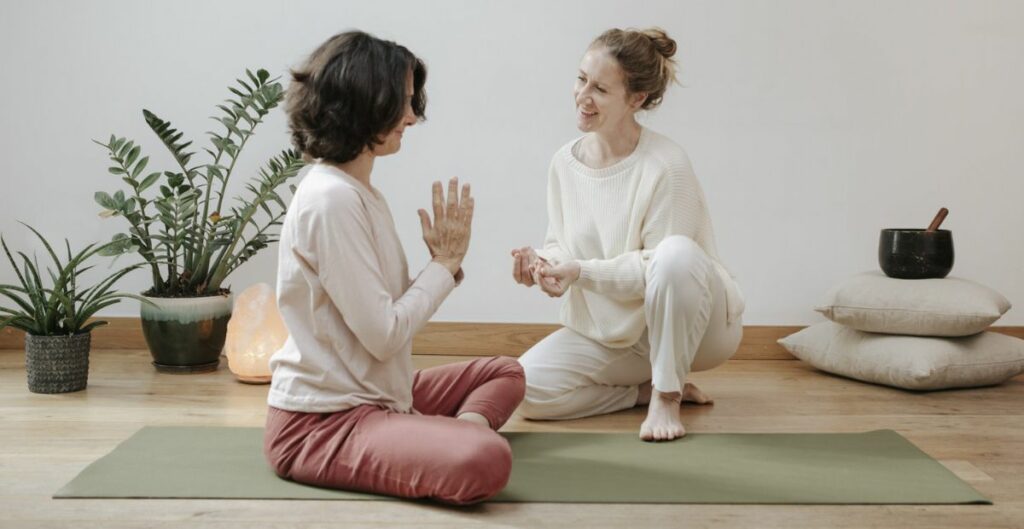Practices like Kundalini Yoga for Mental Health have become popular because they can help you. This old form of yoga, known as the “yoga of awareness,” looks at balancing the mind, body, and spirit. Exploring how Kundalini Yoga helps mental well-being shows many benefits beyond flexibility and exercise.
In This Article
What Is Kundalini Yoga for Mental Health?

Kundalini Yoga, often called the “yoga of awareness,” is a transformative practice from ancient Indian traditions. Unlike other forms of yoga, Kundalini focuses on awakening the dormant energy within the body, known as Kundalini energy, which resides at the base of the spine. Through dynamic movements, breathwork, meditation, and chanting, this practice aims to unleash this vital energy, fostering mental clarity and emotional balance.
Kundalini yoga for mental health involves specific exercises called “kriyas,” each designed to target various aspects of the body and mind. These kriyas encompass a fusion of postures, breath control, and chanting, orchestrated to awaken and balance the chakras, the energy centers within the body.
5 Reasons To Do Kundalini Yoga for Mental Health

There are five good reasons to try Kundalini Yoga for mental health:
● Stress Relief: Doing breathwork, movement, and meditation in Kundalini Yoga helps reduce stress. It syncs breathing with movement to bring inner calm, lowering the main stress hormone called cortisol.
● Emotional Control: Kundalini Yoga teaches how to handle emotions better. Specific exercises and meditations help release and balance emotions, making dealing with life’s ups and downs easier.
● Clearer Thinking: Kundalini Yoga uses meditation to improve focus and clear thinking. Regular practice can boost memory and concentration, giving a sharper mind.
● Better Sleep: Many facing mental health issues have trouble sleeping. Kundalini Yoga includes relaxation methods that calm nerves and reduce anxiety, leading to better sleep.
● Being Present: Kundalini Yoga teaches mindfulness, urging people to stay focused on the present moment. This helps understand oneself better and handle life’s challenges more thoughtfully.
To benefit from Kundalini Yoga for mental health, it’s important to practice regularly, even if it’s just for a short time. Consistency matters a lot for mental and emotional well-being.
How Kundalini Yoga Helps Mental Health

Taking care of your mental well-being is a journey that can be complex, exploring different ways to find balance and peace. Kundalini combines breathing, active poses, and meditation to make a big positive impact inside, creating a safe place for your mental health and emotional balance.
Stress Reduction: Finding Calm

Life’s stresses can build up, making it hard to relax. Kundalini Yoga helps unwind tension in your body through breathing and specific poses. It’s like a reset button for your nerves, calming you and making you more resilient to stress.
Moreover, practicing Kundalini Yoga regularly helps you understand how your body reacts to stress. This awareness allows you to spot stress triggers and deal with them better.
Emotional Regulation: Riding the Emotional Waves
Emotions can be overwhelming, right? Kundalini Yoga teaches you to handle them better. Combining breathing, meditation, and movement makes you more aware of your emotions without letting them control you.
This practice also encourages exploring your feelings in a safe space. It helps you accept vulnerability and become stronger emotionally to face life’s challenges more clearly.
Enhanced Mood and Well-being: Feeling Happier Inside Out
Kundalini Yoga for mental health goes beyond just physical exercise. It boosts your mood by releasing feel-good hormones through breathing and movement techniques. This biochemical change makes you feel content for longer periods.
Plus, practicing Kundalini Yoga helps you connect your mind and body better. This connection lets you recognize and release emotional blocks, bringing a sense of inner harmony that reflects outward.
Improved Focus and Clarity: Sharpening Your Mind
In our busy lives, staying focused can be tough. Kundalini Yoga helps here, too. Its techniques channel energy to your brain, making your thinking clearer and improving your ability to concentrate.
It also encourages you to be more mindful in your daily activities. This helps you fully engage in whatever you’re doing, making you more productive and mentally engaged.
Better Sleep Patterns: Getting Restful Sleep
Good sleep is crucial for mental health. With its calming exercises, Kundalini Yoga helps set the stage for restful sleep. Releasing physical and mental tension prepares your body and mind for deep sleep.
It also helps transition your mind from a busy state to a relaxed one before bedtime. This relaxation reduces the impact of stress hormones, allowing you to sleep peacefully. This kind of restorative sleep rejuvenates your mind and helps you emotionally recharge.
Kundalini Yoga offers a holistic way to boost mental well-being. Its simple practices can help you become more resilient, find inner peace, and handle emotions better. As you dive into this practice, you might discover that Kundalini Yoga becomes your guiding light toward mental rejuvenation and deep inner peace.
Guidelines For Embracing Kundalini Yoga for Mental Health

Kundalini Yoga stands as a profound practice, unlocking the potential for inner awakening and holistic wellness. It is rooted in ancient traditions and offers a gateway to spiritual growth, mental clarity, and physical vitality. Embracing Kundalini Yoga is not merely about performing poses; it’s a journey toward self-discovery and profound transformation. Here are five essential guidelines to enrich and deepen your Kundalini Yoga practice:
Connect with Breath
Kundalini Yoga for mental health emphasizes the significance of breath as the conduit for energy flow. Through pranayama techniques, practitioners tap into the life force—Prana—to awaken the dormant energy at the base of the spine.
Conscious breathing synchronizes with movement, elevating awareness and calming the mind. The Breath of Fire, a fundamental technique, involves rapid, rhythmic breathing to cleanse and invigorate the body. Remember, the breath is not just air; it’s the bridge connecting body, mind, and spirit.
Honoring Mantras And Chanting
In Kundalini Yoga, mantras serve as potent tools for elevating consciousness. When chanted or meditated upon, these sacred sounds or phrases produce vibrations that resonate within and around us. Reciting mantras like “Sat Nam,” meaning “Truth is my identity,” tunes one into the universal truth.
Delve into the uplifting power of mantra chanting, allowing it to awaken your inner essence and dissolve barriers that hinder spiritual growth. The reverberations of these chants create a harmonious symphony within, fostering serenity and heightened awareness.
Cultivate Mindfulness And Meditation

The essence of Kundalini Yoga lies in quieting the mind and diving into profound states of meditation. Cultivate mindfulness by observing thoughts without attachment or judgment. Engage in meditation practices such as the Kundalini Meditation, which may involve focusing on a specific mantra or visualizing energy flowing through the chakras. These practices cultivate a serene mental landscape, fostering clarity and nurturing a deeper connection with the self.
Embrace Asanas And Kriyas
Asanas (yogic postures) and Kriyas (specific sequences of postures, breath, and sound) are integral components of Kundalini Yoga. These physical practices aim to balance the glandular system, strengthen the nervous system, and awaken dormant energy.
The dynamic nature of Kundalini Yoga asanas and kriyas helps release physical tension, stimulate energy flow, and activate specific energy centers (chakras) in the body. Embrace these practices with dedication, allowing the body to align with the energy and fostering vitality and equilibrium.
Seek Authentic Learning
Navigating the profound realms of Kundalini Yoga requires guidance from a knowledgeable and experienced teacher. Seek a teacher who embodies authenticity and wisdom, someone capable of transmitting the teachings with reverence and respect.
A qualified instructor provides personalized guidance, ensures correct practice, and offers insights into the nuances of Kundalini Yoga. Remember, the relationship with the teacher is not just instructional but also serves as a spiritual transmission and growth conduit.
FAQ’s:
Now, we delve into six frequently asked questions about Kundalini Yoga, shedding light on its essence and practices.
- What is Kundalini Yoga, and how does it differ from other yoga forms?
Kundalini Yoga, often called the yoga of awareness, transcends the traditional boundaries of yoga practices. Its essence lies in the belief that each individual possesses dormant energy coiled at the base of the spine. This latent energy, known as Kundalini, is believed to be the key to spiritual enlightenment.
Unlike other yoga forms that predominantly focus on physical postures (asanas) to attain bodily health and flexibility, Kundalini Yoga integrates a holistic approach. It combines dynamic movements, specialized breathing techniques (pranayama), chanting (mantras), meditation, and the awakening of spiritual consciousness. This distinct blend distinguishes Kundalini Yoga from its counterparts, emphasizing the awakening and channeling of the Kundalini energy through the body’s energy centers, known as chakras.
Kundalini Yoga’s uniqueness lies in its emphasis on physical well-being and mental, emotional, and spiritual elevation. While many other yoga forms concentrate on the physical aspects, Kundalini Yoga aims at balancing all facets of the self.
- Is Kundalini Yoga suitable for everyone?
Kundalini Yoga’s potency is undeniable, yet its intensity may not align with everyone’s needs or physical capabilities. While it offers profound benefits, it’s essential to approach it mindfully. Beginners or individuals with specific health conditions might find the rapid and intense practices overwhelming.
However, modifications and variations within Kundalini practices exist to accommodate diverse practitioners. Consulting a qualified instructor or healthcare professional is strongly advised before diving into Kundalini Yoga, especially for those with medical concerns or pregnant individuals. Understanding personal limitations and proceeding cautiously can help individuals tailor the practice to suit their unique requirements, ensuring a safe and enriching experience.
What are the key components of a Kundalini Yoga practice?
What are the key components of a Kundalini Yoga practice?
At the core of a Kundalini Yoga session lies a harmonious fusion of various components to elevate consciousness and vitality. Kriyas, specific sequences of postures, breathwork, and sound vibrations form the foundational elements. These kriyas are meticulously crafted to address distinct body, mind, and spirit aspects. Each kriya, comprising a sequence of postures, breath, and sound, serves a specific purpose: enhancing flexibility, balancing emotions, or stimulating energy flow within the body. Alongside kriyas, practitioners engage in pranayama, employing breathing techniques to regulate and amplify the flow of vital life force, or prana, within the body. The rhythmic patterns of breathwork synchronize with movements, amplifying the practice’s transformative potential.
- What can one expect from a Kundalini Yoga class?
Stepping into a Kundalini Yoga class is akin to embarking on a transformative journey transcending the physical realm. Expect a vibrant and dynamic atmosphere, often enveloped in sacred chants and a sense of communal energy. Each class is a unique tapestry woven with diverse kriyas, breathwork, and meditative practices. The sequences of movements, synchronized with specific breathing patterns, might seem unconventional at first but gradually reveal their profound impact. Chanting mantras in unison or individually infuses the space with powerful vibrations, creating an environment conducive to self-discovery and spiritual elevation.
- Are there specific benefits associated with practicing Kundalini Yoga?
The benefits of Kundalini Yoga extend beyond the physical realm. Regular practitioners often report enhanced mental clarity, reduced stress levels, increased energy, and improved emotional balance. Moreover, Kundalini’s emphasis on spiritual elevation can lead to a deeper understanding of oneself and a heightened sense of interconnectedness with the universe.
- How does one begin practicing Kundalini Yoga?
Embarking on a Kundalini Yoga journey requires a few simple yet essential steps. First, seek guidance from a qualified instructor or reputable resources to gain a foundational understanding of Kundalini practices. Invest in comfortable clothing, asanas-friendly attire, and a yoga mat. Start slowly, acquainting yourself with basic kriyas and pranayama techniques. Consistency and patience are key; allow your practice to evolve gradually.
Incorporating Kundalini Yoga into your routine needs commitment. Regular practice helps you understand yourself better, easing stress and emotional ups and downs. Getting guidance from experienced instructors or joining a supportive community can make your journey more enriching.
Conclusion
Kundalini Yoga for mental health operates holistically, aligning deeply with mental health concerns. Its comprehensive techniques serve as a roadmap toward achieving balance, providing individuals with tools to navigate the intricate challenges of modern life. This practice empowers people, granting them the resilience to face life’s complexities while maintaining inner peace.
Individuals who engage more deeply in Kundalini Yoga uncover its transformative potential. It acts as a guiding beacon on their journey toward improved mental well-being. Through this ancient discipline, anyone can understand their emotions and maintain a healthy mental state.
Read Also:







